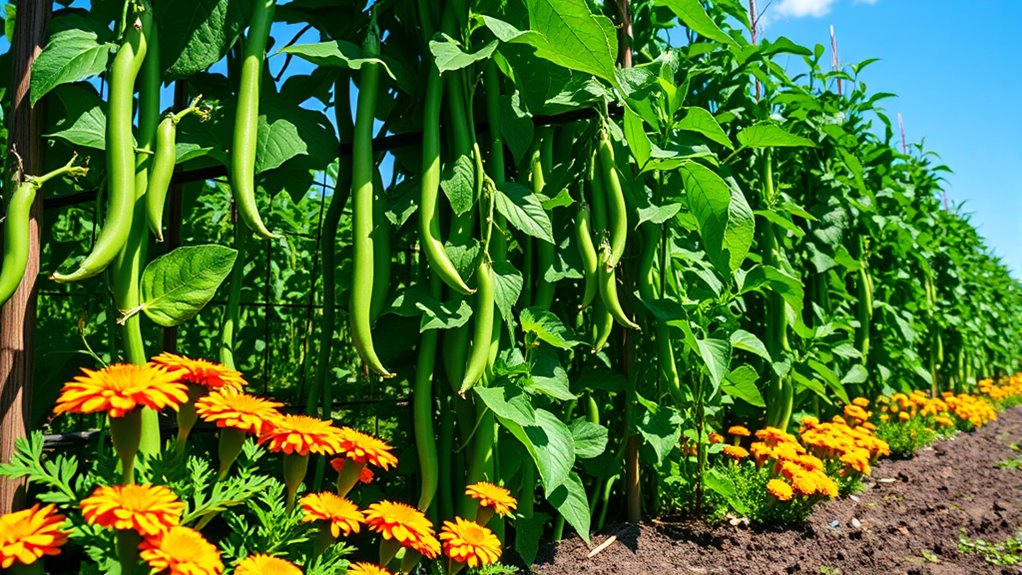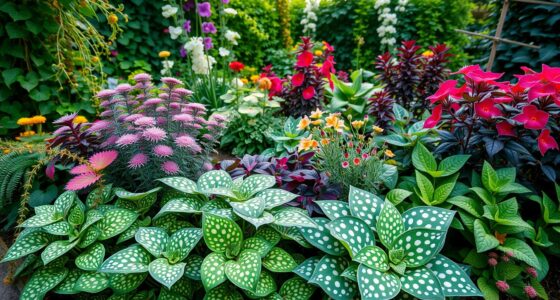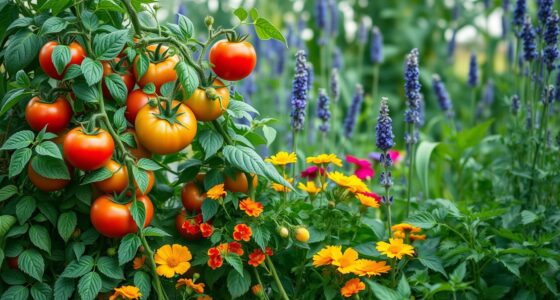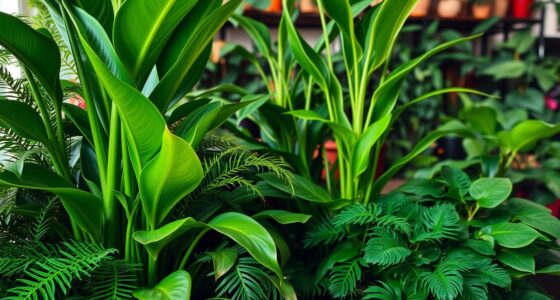To optimize your bean garden, plant them near supportive crops like corn, cucumbers, and herbs like basil, which help repel pests and improve soil nitrogen. Avoid proximity to tomatoes, alliums, and brassicas, as they can attract pests or hinder bean growth. Proper spacing, crop rotation, and companion plants boost health and yield. If you keep exploring, you’ll discover more detailed tips to create a thriving and balanced garden ecosystem.
Key Takeaways
- Plant beans alongside corn, cucumbers, or squash for support, shade, and efficient space use.
- Avoid planting beans near tomatoes, alliums, fennel, or brassicas to prevent pest attraction and nutrient competition.
- Incorporate herbs like basil and marigolds to repel pests and enhance bean growth and flavor.
- Rotate beans with other legumes and rotate crops seasonally to improve soil health and prevent disease.
- Use mulch, proper spacing, and companion plants to promote airflow, pest control, and a balanced garden ecosystem.
Best Companion Plants for Beans
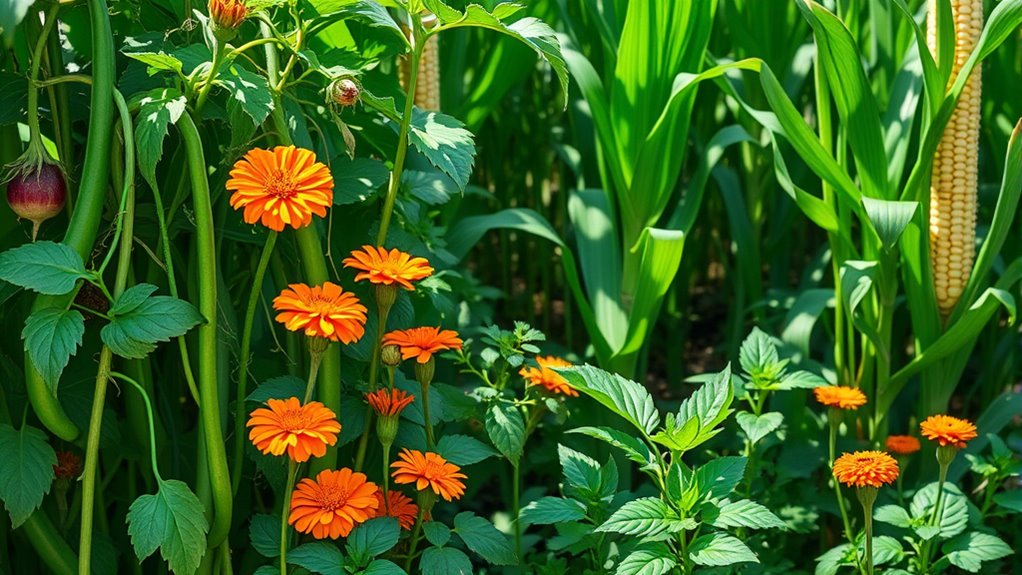
When choosing companion plants for beans, selecting the right ones can boost your harvest and improve plant health. Beans thrive alongside crops like corn, which provides natural support for climbing varieties, and cucumbers, which don’t compete for nutrients. Nasturtiums and marigolds also make great companions because they help repel pests and attract beneficial insects. Spinach and radishes are good options too, as they grow quickly and don’t overshadow the beans, making efficient use of space. These companions can enhance soil health, deter pests, and encourage beneficial insects to visit your garden. Additionally, understanding the historical agricultural practices behind crop combinations can help you design a more sustainable and productive garden environment. Incorporating integrated pest management techniques can further support healthy plant growth and reduce reliance on chemical interventions. By pairing beans with these plants, you create a diverse, productive garden environment that supports healthy growth and maximizes your yield. Considering soil rotation strategies can also help maintain nutrient balance and prevent soil depletion over time.
Plants to Avoid Growing Near Beans

Certain plants can hinder the growth of beans and should be kept apart to guarantee a healthy harvest. Tomatoes, for example, can attract pests like spider mites and aphids that also target beans, increasing pest pressure. Alliums such as garlic, onions, and leeks release compounds that may suppress bean growth, so avoid planting them nearby. Fennel is another plant to steer clear of because it can inhibit the development of beans through its allelopathic effects. Additionally, plants in the brassica family—like cabbage, broccoli, and cauliflower—compete for similar nutrients and may shade beans, reducing their sunlight exposure. To promote healthy growth, keep these plants separate from your beans, ensuring they don’t compete for resources or attract harmful pests. Proper plant spacing is essential to prevent competition and ensure adequate airflow, reducing the risk of disease and pest infestations. Understanding plant interactions and their effects on growth can help optimize your garden layout for better yields. Incorporating knowledge about glycolic acid benefits can also improve your gardening routines by promoting healthier plant skin and vigor.
Tips for Successful Companion Planting With Beans
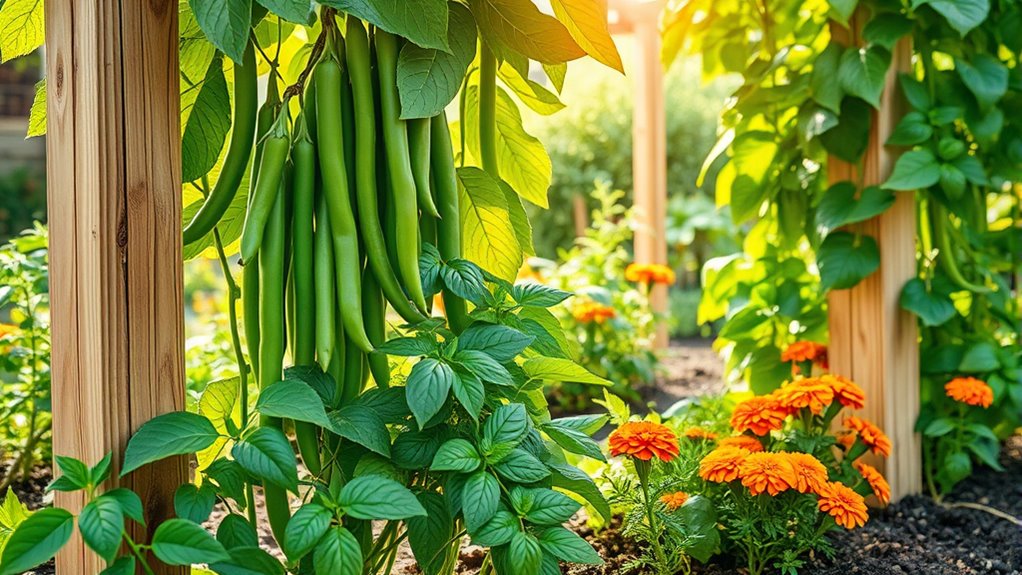
To maximize the benefits of companion planting with beans, focus on strategic placement and diverse plant choices that enhance growth and deter pests. Plant beans alongside crops like corn or squash, which can provide natural support or shade. Rotate beans with other legumes to improve soil nitrogen and prevent disease buildup. Keep pests in mind; interplant beans with herbs like basil or marigolds to repel insects. Guarantee proper spacing to promote airflow and reduce disease risk. Mulching helps retain moisture and suppress weeds, supporting healthy bean growth. Regularly monitor plants for pests or signs of stress, and promptly address issues to maintain a healthy garden. Understanding plant compatibility can further optimize your planting success. Incorporating garden planning techniques can help you design an efficient and productive planting layout. By planning your plant combinations thoughtfully, you’ll create a thriving, pest-resistant environment that boosts your bean harvest.
Benefits of Planting Beans With Specific Vegetables and Herbs
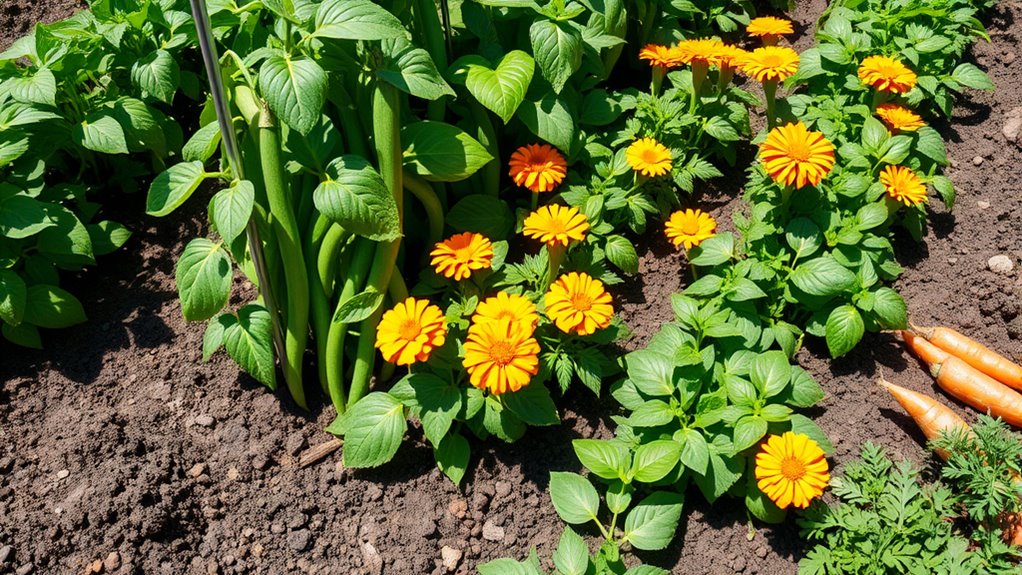
Planting beans alongside specific vegetables and herbs offers unique advantages that can enhance your garden’s productivity and health. Beans fix nitrogen in the soil, benefiting nearby plants like corn and peas that need extra nutrients. Herbs like basil and parsley can repel pests and improve bean flavor. Additionally, planting beans with carrots or radishes can help break up soil, making it easier for roots to grow. Companion planting also minimizes pest issues by attracting beneficial insects and deterring harmful ones. Below is a helpful table highlighting some effective pairings:
| Vegetables & Herbs | Benefits of Planting with Beans |
|---|---|
| Corn, Peas | Nitrogen fixation, shared space efficiency |
| Basil, Parsley | Pest control, flavor enhancement |
| Carrots, Radishes | Soil aeration, pest deterrence |
| Marigolds | Pest repellent, pollinator attraction |
Creating a Balanced and Productive Garden Ecosystem
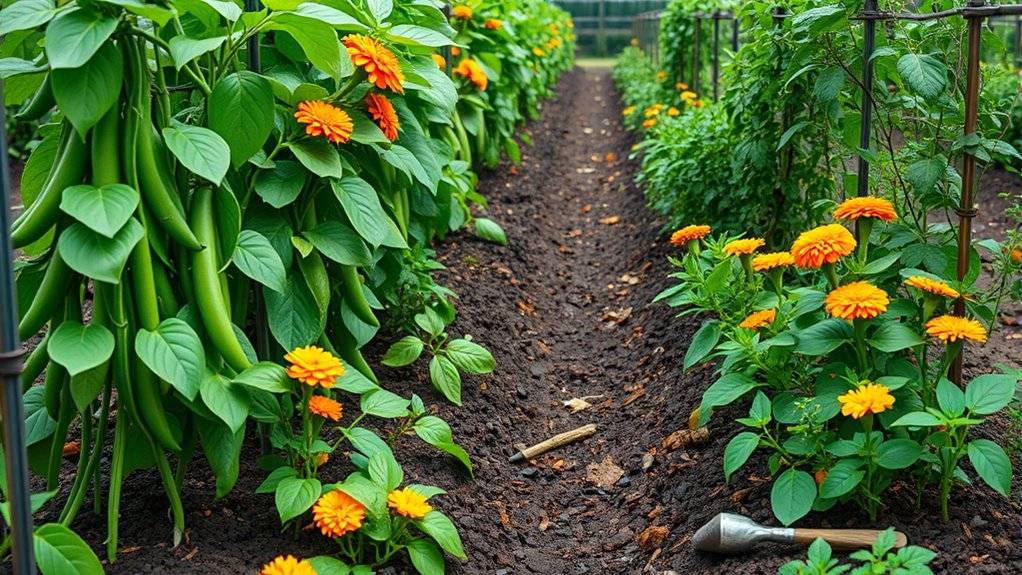
Creating a balanced and productive garden ecosystem requires intentional planning and diverse plantings that support each other. You should select plants that complement one another, enhancing soil health, pest control, and overall productivity. Incorporate nitrogen-fixing beans alongside vegetables like tomatoes and corn, which benefit from this natural fertilization. Mix herbs like basil or marigolds to repel pests and attract beneficial insects. Avoid monocultures; instead, rotate crops each season to prevent soil depletion and reduce disease buildup. Mulch around plants to retain moisture and suppress weeds. Consider introducing pollinator-friendly plants, such as flowers, to boost pollination and yield. By thoughtfully combining plants, you create a resilient, thriving ecosystem that maximizes your garden’s health and productivity. Understanding key elements of plant compatibility can further improve your planting success. Additionally, recognizing pest-resistant plant varieties can help you naturally reduce the need for chemical interventions and promote healthier growth. Incorporating soil improvement techniques can also enhance nutrient availability and support robust plant development.
Frequently Asked Questions
How Do I Rotate Bean Companion Plants Annually?
To rotate your bean companion plants annually, start by tracking where you plant each crop each season. Each year, move beans and their companions to different beds to prevent soil depletion and reduce pests. Avoid planting beans where nightshades or alliums grew recently. Keep a planting calendar, and plan rotations that include legumes, leafy greens, and root vegetables to maintain healthy soil and maximize yields.
Can Beans Be Planted With Non-Vegetable Garden Plants?
You can plant beans alongside non-vegetable garden plants, but choose wisely. Beans benefit from plants that provide support, like certain flowers, or that improve soil health, such as herbs like basil or dill. Avoid planting beans near invasive plants or those that may compete for nutrients. By selecting compatible plants, you’ll promote healthy growth and a diverse, thriving garden. Just keep an eye on their specific needs and growth habits.
What Soil Amendments Improve Bean and Companion Plant Growth?
To improve bean and companion plant growth, you should enrich your soil with organic matter like compost or well-rotted manure. Adding a balanced fertilizer with nitrogen, phosphorus, and potassium supports healthy development. You might also consider incorporating lime if your soil is too acidic or sulfur if it’s too alkaline. These amendments create a nutrient-rich environment, ensuring your plants grow strong, healthy, and productive.
How Do Pests Affect Beans and Their Companions?
Pests can be like uninvited guests at a picnic, ruining your efforts. They damage beans and their companions by feeding on leaves, stems, and roots, weakening plants and spreading diseases. This can lead to stunted growth, reduced yields, and even plant death. Regular inspection, natural predators, and organic pest control methods help protect your garden, ensuring your beans and their companions thrive without harm.
Are There Any Regional Considerations for Bean Companion Planting?
Regional considerations for bean companion planting matter because climate, soil, and local pests vary. You should choose plants suited to your area’s conditions to boost growth and ward off pests naturally. For example, in humid regions, avoid overly dense plantings that promote disease. Research your region’s native plants and pests, and select companions that thrive in your specific environment to maximize your garden’s success.
Conclusion
By pairing beans with the right companions, you create a thriving garden ecosystem. Imagine planting beans alongside basil, which repels pests and boosts flavor—your garden becomes more productive and healthier. With some planning, you avoid pitfalls like planting beans near garlic, which can hinder growth. When you choose wisely, you’ll enjoy a bountiful harvest and a vibrant garden that’s easier to maintain and more resilient. Start experimenting today and watch your garden flourish!
